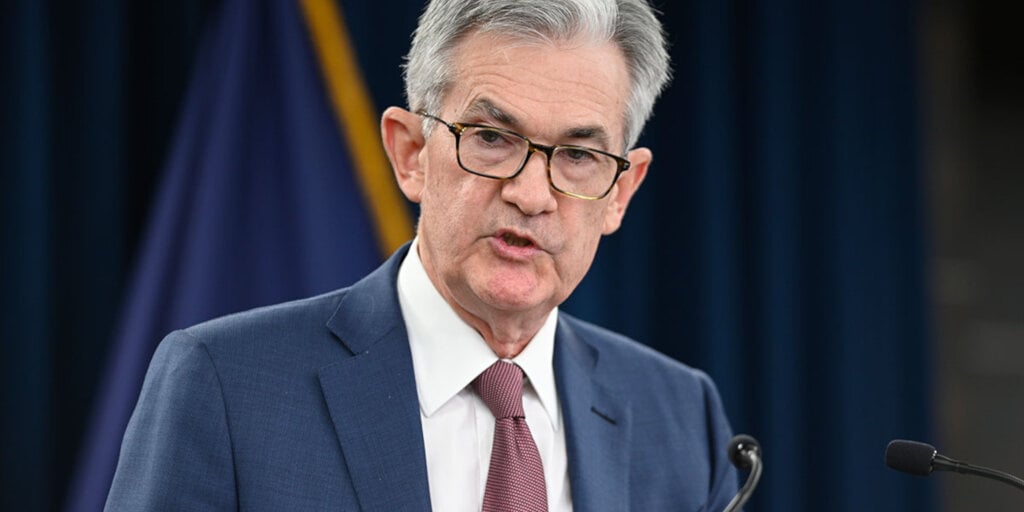The price of Bitcoin rose Friday as Federal Reserve Chairman Jerome Powell teed up rate cuts in the coming months, signaling the U.S. central bank is pleased with cooling inflation while being more attentive to growing weakness in the labor market.
“The direction of travel is clear, and the timing and pace of rate cuts will depend on incoming data, the evolving outlook, and the balance of risks,” he said while delivering a keynote address at this year’s Jackson Hole Economic Policy Symposium in Wyoming.
Bitcoin’s price had risen 1.8% to $61,500 over the past day, as of this writing, but briefly popped above $62,000 following Powell’s comments. Meanwhile, the price of Ethereum and Solana had increased 2.7% and 2.1%, respectively, to $2,675 and $145.
At this point, markets are confident that the Fed will ease up in its inflation fight after holding its benchmark interest rate steady since July 2023. As of this writing, traders penciled in a 32% chance that the Fed cuts rates by 0.50% in September, while assigning a 67% chance to a 0.25% rate cut, according to CME Fedwatch.
Inflation rose to a four-decade high of 9.1% in June 2022, as the U.S. economy came roaring back from pandemic-related slowdowns. In an effort to tame soaring consumer prices, the U.S. central bank responded by raising interest rates to their highest levels since 2007 over time.
“Generally, a rate cut bodes well for risk-on assets, which have historically enjoyed the expansion of investor appetite as borrowing costs decrease,” Leena ElDeeb, a research associate at 21Shares, told Decrypt.
She added that Powell’s remarks “reassured that it’s time for the Fed’s policy to change provided that upcoming economic data comes in about as expected.”
In 2021, policymakers viewed an initial “spike” in the price of consumer goods, such as motor vehicles, as transitory, Powell said. It later became evident that restoring price stability would require a “strong response” from the Fed, as the economy continued to run red hot, he said.
As the Fed began raising interest rates, making it more expensive for businesses and consumers to borrow, the labor market remained especially tight. The Fed pointed to this as a source of concern for months, as workers used the opportunity to bargain for higher wages.
“Some argued that getting inflation under control would require a recession and lengthy period of high unemployment,” Powell recalled, adding that “it seems unlikely that the labor market will be a source of elevated inflationary pressures anytime soon.”
The Fed’s dual mandate is oriented around stable prices and maximum unemployment. As the pace of inflation has slowed to 2.9% in the 12 months through June, the unemployment rate has ticked up to 4.3%—rising from a historic low 3.4% in February 2023.
Citing the ratio of unemployment to job vacancies, Powell said the labor market resembles its pre-pandemic state. At the same time, he said Fed policymakers have been able to reduce a “frantic pace of hiring,” while preventing the economy from slowing too much.
Navigating a decades-high bout of elevated inflation, the Fed has faced a challenge. Cutting interest rates too early could lead to inflation remaining entrenched, while holding interest rates higher for too long could suffocate the economy’s growth, tipping it into a recession.
“The upside risks to inflation have diminished and the downside risk to employment have increased,” Powell said. “We do not seek or welcome further pooling in labor market conditions.”
While taking a more restrictive monetary stance, the Fed had to navigate curveballs like snarled supply chains that lasted “much longer than expected” because of extended COVID-19 lockdowns in China, Powell said. At the same time, “severe shocks to energy and commodity markets” complicated matters as the Fed aimed to rein in rising prices, he added.
For months, Powell has said the U.S. central bank is looking for “greater confidence” that inflation will return to normal levels, reprising the phrase as recently as July. Yet, during his Wednesday address, the phrase went unmentioned.
“All told, the healing from pandemic distortions, our efforts to moderate aggregate demand, and the anchoring of expectations have worked together to put inflation on what increasingly appears to be a sustainable path to our 2% objective,” Powell said.
Editor’s note: This story was updated after publication with additional details.
Edited by Andrew Hayward
Daily Debrief Newsletter
Start every day with the top news stories right now, plus original features, a podcast, videos and more.


